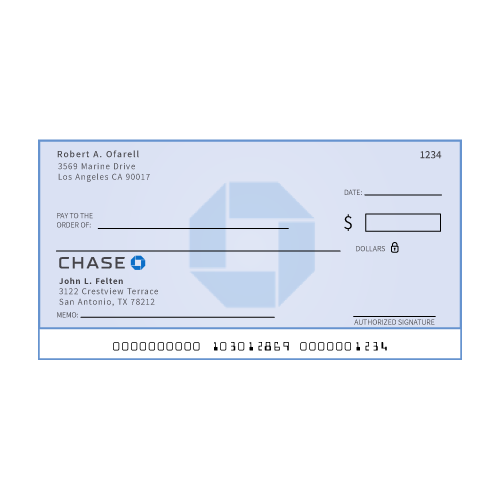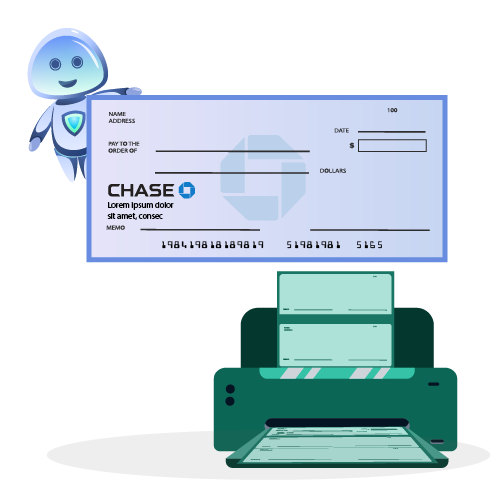So here we are, diving headfirst into the world of financial inquiries, specifically answering the burning question: how many checks are in a book chase? If you're scratching your head wondering what this even means, don't worry, pal. We've got you covered. This isn't just another random query; it's a crucial piece of information for anyone dealing with banking or financial management. Whether you're managing your personal finances or running a small business, understanding checks and their quantities is essential. Let's break it down step by step.
Before we jump into the nitty-gritty, let's clear the air. The phrase "checks in a book chase" might sound confusing at first glance, but it's simpler than you think. Essentially, when we talk about checks in a book, we're referring to the number of checks provided in a single checkbook. Chase, in this context, refers to Chase Bank, one of the largest financial institutions in the United States. So, if you're asking how many checks are in a book chase, you're really asking about the standard number of checks included in a checkbook from Chase Bank.
Now that we've set the stage, let's dive deeper into the details. This article isn't just about numbers; it's about empowering you with knowledge. By the time you finish reading, you'll have a clear understanding of how checkbooks work, why they matter, and how to make the most out of them. Ready to get started? Let's go!
Read also:Crew Gaines Down Syndrome Celebrating The Life And Achievements Of An Extraordinary Individual
Understanding the Basics: What Is a Checkbook?
A checkbook is essentially a collection of pre-printed checks, all neatly bound together in a small booklet. It's like your personal ticket to accessing funds from your bank account. Each check serves as a legal document authorizing the bank to transfer a specific amount of money to the recipient. In today's digital age, checkbooks might seem outdated, but they still hold immense value, especially for those who prefer traditional banking methods.
Here are some key points about checkbooks:
- Checkbooks typically come with a carbon copy for record-keeping.
- They are issued by banks and linked directly to your checking account.
- Using a checkbook helps you maintain a detailed record of your transactions.
Understanding the basics of checkbooks is crucial before diving into specifics like how many checks are in a book chase. It's not just about the number; it's about the functionality and purpose behind each check.
How Many Checks Are in a Book Chase?
Alright, let's cut to the chase (pun intended). So, how many checks are in a book chase? Typically, Chase Bank provides 25 checks per checkbook. This number might vary slightly depending on the type of account or special requests, but 25 is the standard quantity. It's a manageable number designed to last several months for most users.
Now, you might be wondering why Chase limits the number of checks to 25. Well, it's all about convenience and sustainability. Having too many checks in one book could lead to mismanagement or loss, while too few might force you to reorder frequently. The 25-check standard strikes a perfect balance.
Factors Influencing Checkbook Sizes
While 25 checks per book is the norm, there are certain factors that can influence the size of your checkbook:
Read also:Stevie Wonder Children A Journey Through Music Legacy And Family
- Account Type: Some premium accounts might offer larger checkbooks as a perk.
- Customer Requests: If you're a frequent check user, you can always request a custom quantity from Chase.
- Bank Policies: Policies might vary slightly across different branches or regions.
It's always a good idea to confirm with your local Chase branch if you have specific requirements. Flexibility is key, and Chase is generally accommodating to its customers' needs.
Why Does the Number of Checks Matter?
Now that we know the standard number of checks in a book chase, you might be wondering why it matters. Well, the number of checks in a checkbook directly impacts how you manage your finances. If you use checks frequently, you'll want to ensure you have enough on hand without overstocking. On the flip side, if you rarely use checks, a smaller quantity might suffice.
Here are a few reasons why the number of checks matters:
- Financial Planning: Knowing how many checks you have helps you plan your expenses more effectively.
- Security: A limited number of checks reduces the risk of loss or theft.
- Convenience: Ordering new checks when needed ensures you never run out unexpectedly.
In today's fast-paced world, where digital payments dominate, checks might seem like a relic of the past. However, they still hold immense value in certain scenarios, such as paying rent, settling large bills, or transferring funds to individuals who prefer checks.
Common Misconceptions About Checkbooks
There are a few misconceptions floating around about checkbooks that we need to address. Let's debunk some of these myths:
- Checkbooks Are Obsolete: While digital payments are on the rise, checkbooks are still widely used, especially in formal transactions.
- Checks Are Risky: As long as you keep your checkbook secure and verify transactions, checks are just as safe as any other payment method.
- Checkbooks Are Expensive: In reality, most banks, including Chase, offer checkbooks as part of their standard services without additional charges.
Understanding these misconceptions can help you make informed decisions about using checkbooks in your financial life.
How to Order More Checks from Chase
Running out of checks? No worries. Ordering more checks from Chase is a breeze. Here's how you can do it:
- Online: Log in to your Chase account and navigate to the "Order Checks" section.
- In Person: Visit your nearest Chase branch and speak to a representative.
- By Phone: Call Chase customer service and request a new checkbook.
It's always a good idea to reorder before you run out completely to avoid any inconvenience. Chase typically delivers new checkbooks within a week, so plan accordingly.
How Often Should You Use Checks?
The frequency of check usage depends on your personal or business needs. Some people use checks daily, while others might not use them for months. The key is finding a balance that works for you. If you're a small business owner, you might use checks more frequently for vendor payments or payroll. On the other hand, if you're managing personal finances, checks might only come into play for specific occasions.
Here are a few tips to help you decide how often to use checks:
- Assess Your Needs: Evaluate your financial transactions and determine where checks fit in.
- Monitor Your Balance: Keep track of your account balance to ensure you have sufficient funds for check payments.
- Stay Organized: Maintain a record of all your checks to avoid duplication or errors.
Remember, checks are just one tool in your financial arsenal. Use them wisely and strategically.
Advantages of Using Checks
Despite the rise of digital payments, checks still offer several advantages:
- Legal Documentation: Checks provide a tangible record of transactions, which can be invaluable in legal disputes.
- Flexibility: You can write checks for any amount, making them ideal for large or irregular payments.
- Security: Unlike cash, checks can be canceled or stopped if lost or stolen.
These advantages make checks a reliable option for certain types of transactions, even in today's digital age.
How Chase Supports Checkbook Users
Chase Bank is committed to supporting its checkbook users through various services and resources. From offering free checkbooks to providing detailed guides on check usage, Chase ensures its customers have everything they need to manage their finances effectively.
Here are some ways Chase supports checkbook users:
- Free Checkbooks: Chase provides checkbooks at no additional cost to most account holders.
- Customer Support: Dedicated representatives are available to assist with any check-related queries.
- Educational Resources: Chase offers guides and tutorials to help users make the most out of their checkbooks.
With these resources at your disposal, managing your checkbook has never been easier.
Tips for Managing Your Checkbook Efficiently
To make the most out of your checkbook, here are a few tips:
- Keep Track of Your Checks: Use a check register to record every check you write.
- Secure Your Checkbook: Store it in a safe place to prevent loss or theft.
- Review Your Statements: Regularly check your bank statements to ensure all checks have been processed correctly.
By following these tips, you can ensure your checkbook remains a valuable asset in your financial toolkit.
Conclusion: Embrace the Power of Checks
And there you have it, folks. We've explored the world of checkbooks, focusing on the crucial question: how many checks are in a book chase? The answer, as we discovered, is typically 25 checks per book, but the possibilities extend beyond that number depending on your needs and preferences.
Checks might not be the flashiest payment method out there, but they remain a reliable and secure option for countless transactions. Whether you're managing personal finances or running a business, understanding how to use checkbooks effectively can make a significant difference in your financial management.
So, what's next? Take action! If you're a Chase customer, order your checkbook today and start leveraging this powerful financial tool. Don't forget to share this article with friends and family who might benefit from the insights. Together, let's embrace the power of checks and take control of our financial futures. Cheers!
Table of Contents
- Understanding the Basics: What Is a Checkbook?
- How Many Checks Are in a Book Chase?
- Factors Influencing Checkbook Sizes
- Why Does the Number of Checks Matter?
- Common Misconceptions About Checkbooks
- How to Order More Checks from Chase
- How Often Should You Use Checks?
- Advantages of Using Checks
- How Chase Supports Checkbook Users
- Tips for Managing Your Checkbook Efficiently


